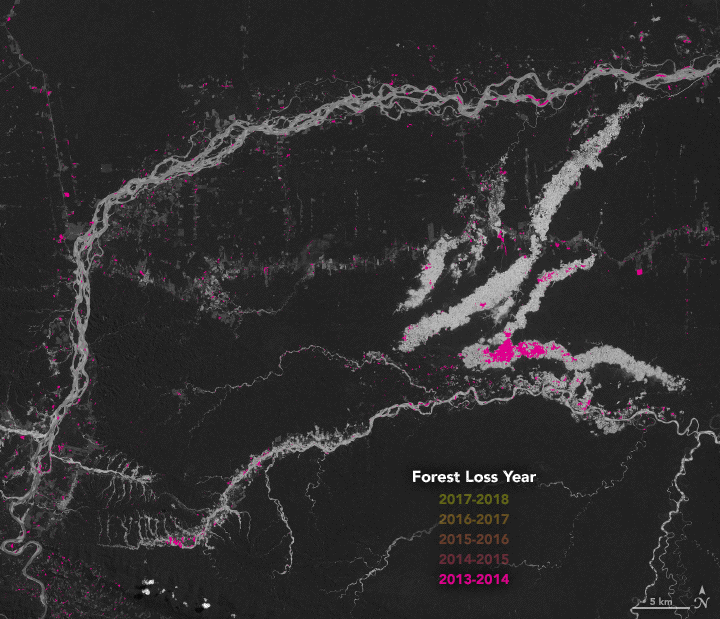Watch Forests in Peru Disappear Over 5 Years, in Startling NASA Satellite Views

Years of deforestation in Peru are visible from space, tracked in a new animation created from NASA satellite views. And the forest loss is escalating at an alarming rate.
The image series was captured by satellites Landsat 7 and Landsat 8 from 2013 to 2018. Shared on April 19 by NASA Earth Observatory, the animated sequence reveals devastating depletion in the forests of southeastern Peru's Madre de Dios region, covering approximately 1,350 square miles (3,500 square kilometers).
Andrea Nicolau, a graduate research assistant at the University of Alabama in Huntsville, mapped forest loss in the images using a technique known as spectral mixture analysis, which differentiates between types of land cover based on light properties in every pixel, according to NASA. Using this method, Nicolau determined that about 79 square miles (206 square km) of forest disappeared during the five-year period, and the greatest loss took place between 2017 and 2018. [Gallery: Rare Species of the Andes and Amazon]
The hardest-hit areas were found in buffer zones close to protected areas. Illegal gold mining is responsible for much of the deforestation on lands belonging to the indigenous Peruvian tribe known as Kotsimba Native Community. Indeed, those involved with mining operations and other activities that threaten Peruvian forests now have easier access to remote locations following the recent completion of Peru's Interoceanic Highway, NASA reported.
Madre de Dios rests near the Amazon basin and is a biodiversity hotspot, home to species that live nowhere else on Earth. But with deforestation on the rise, plants and animals that are endemic to the region face an uncertain future. By tracking and analyzing patterns of forest loss, conservationists and government officials can better strategize how to protect vulnerable species, according to NASA.
- Amazon Photos: Trees That Dominate the Rain Forest
- Photos: Huge Swath of Amazon Preserved in Record-Setting Deal
- Gallery: Images of Uncontacted Tribes
Originally published on Live Science.
Sign up for the Live Science daily newsletter now
Get the world’s most fascinating discoveries delivered straight to your inbox.

Mindy Weisberger is an editor at Scholastic and a former Live Science channel editor and senior writer. She has reported on general science, covering climate change, paleontology, biology and space. Mindy studied film at Columbia University; prior to Live Science she produced, wrote and directed media for the American Museum of Natural History in New York City. Her videos about dinosaurs, astrophysics, biodiversity and evolution appear in museums and science centers worldwide, earning awards such as the CINE Golden Eagle and the Communicator Award of Excellence. Her writing has also appeared in Scientific American, The Washington Post and How It Works Magazine. Her book "Rise of the Zombie Bugs: The Surprising Science of Parasitic Mind Control" will be published in spring 2025 by Johns Hopkins University Press.










